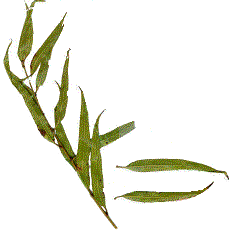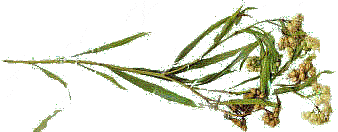Native Plants in the Santa Clara River
Trees
Western Sycamore
(Platanus racemosa)


Majestic tree 30-70 feet tall. Deciduous (loses leaves in winter). Thin bark shreds beautifully. Fuzzy palm-shaped leaves, spiny fruit balls/seed pods. Near water, but outside of normal flows.
Provides cover for birds and small mammals, nesting sites, food.
Hairs on leaves can irritate skin.
Cottonwood
(Populus fremontii, Populus trichocarpa)


Tall tree 30-90 feet tall. Broad, open crown with whitish cracked bark .Deciduous (loses leaves in winter). One of the tallest trees in the floodplain, with characteristic leaves that flutter loudly in a strong breeze.
Present in the upper terraces of river system, where groundwater is available all year round, but actual flooding is intermittent. Needs newly deposited sand bars for seedling germination.
Provides cover for birds and small mammals, nesting sites, food.
Willow
(Salix lasiolepus [Arroyo], Salix gooddingii [Black])


Tree from 6-30 or more feet tall. Deciduous (loses leaves in winter). Slender leaves distinguish the two species: Black Willow has finely toothed edges; those of the Arroyo Willow are smooth. Located in river bottom, this tree is unusual in that it can sprout from branches that make contact with damp ground, or are buried by sand swept by the flow.
Young leaf “buds” contain salicylic acid, the active ingredient in aspirin.
Shrubs and Herbs
Coyote Brush
(Baccharis pilularis)

Dense shrub 2-5 feet tall. Stubby, toothed leaves; small cream colored flowers (not showy) appear in fall. Located in upper terraces of riverbed, and on adjacent slopes. Provides browse for deer and other herbivores during fall and winter.
Mugwort
(Artemisia douglasiana)

Smallish perrenial herb (herbs do not form wood like shrubs do), up to 3 feet in flower with toothed leaves. Leaves are distinctive in having a dark green on top but very light color underneath. Small cream colored flowers (not showy) appear in fall. Often in the understory of cottonwoods and willows. Rumored to help with poison oak. Also used to stimulate dreams by putting dried leaves in a small pillow!
Mulefat
(Baccharis salicifolia)

Scraggly looking shrub 3-7 feet tall. Elongated, toothed leaves; small cream colored flowers throughout the year, although most common in spring and fall. Resembles a small willow. Grows readily anywhere there is moisture, andis common on river terraces. Provides browse for deer and other herbivores during fall and winter. In fact, it’s common name, mulefat, indicates it is good forage for domestic animals, too.
Western Ragweed
(Ambrosia psilostachys)

Small annual (grows from seed, flowers, sets fruit and dies all in one 12-month cycle) herb up to 3 feet when flowering. Very common in the late summer and fall. Fuzzy leaves distinguish it from other similar plants, and has small yellowish flowers.
Often in the understory of cottonwoods and willows, but also out in the floodplain. Likes disturbed areas. In fact, this is one of the first plants to establish itself after flooding.
This is one of the most common allergens in Southern California (followed closely by olive trees).
You must be logged in to post a comment.